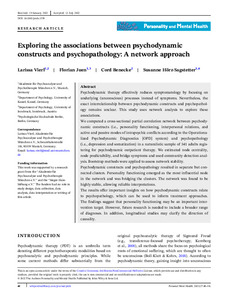| dc.date.accessioned | 2023-03-27T09:46:56Z | |
| dc.date.available | 2023-03-27T09:46:56Z | |
| dc.date.issued | 2022-07-25 | |
| dc.identifier | doi:10.17170/kobra-202303277704 | |
| dc.identifier.uri | http://hdl.handle.net/123456789/14532 | |
| dc.description.sponsorship | Gefördert im Rahmen des Projekts DEAL | |
| dc.language.iso | eng | |
| dc.rights | Attribution-NonCommercial-NoDerivatives 4.0 International | * |
| dc.rights.uri | http://creativecommons.org/licenses/by-nc-nd/4.0/ | * |
| dc.subject.ddc | 150 | |
| dc.title | Exploring the associations between psychodynamic constructs and psychopathology: A network approach | eng |
| dc.type | Aufsatz | |
| dcterms.abstract | Psychodynamic therapy effectively reduces symptomatology by focusing on underlying (unconscious) processes instead of symptoms. Nevertheless, the exact interrelationship between psychodynamic constructs and psychopathology remains unclear. This study uses network analysis to explore these associations. We computed a cross-sectional partial correlation network between psychodynamic constructs (i.e., personality functioning, interpersonal relations, and active and passive modes of intrapsychic conflicts according to the Operationalized Psychodynamic Diagnostics [OPD] system) and psychopathology (i.e., depression and somatization) in a naturalistic sample of 341 adults registering for psychodynamic outpatient therapy. We estimated node centrality, node predictability, and bridge symptoms and used community detection analysis. Bootstrap methods were applied to assess network stability. Psychodynamic constructs and psychopathology resulted in separate but connected clusters. Personality functioning emerged as the most influential node in the network and was bridging the clusters. The network was found to be highly stable, allowing reliable interpretations. The results offer important insights on how psychodynamic constructs relate to psychopathology, which can be used to inform treatment approaches. The findings suggest that personality functioning may be an important intervention target. However, future research is needed to include a broader range of diagnoses. In addition, longitudinal studies may clarify the direction of causality. | eng |
| dcterms.accessRights | open access | |
| dcterms.creator | Vierl, Larissa | |
| dcterms.creator | Juen, Florian | |
| dcterms.creator | Benecke, Cord | |
| dcterms.creator | Hörz-Sagstetter, Susanne | |
| dcterms.extent | 40-54 | |
| dc.relation.doi | doi:10.1002/pmh.1559 | |
| dc.subject.swd | Psychopathologie | ger |
| dc.subject.swd | Psychodynamik | ger |
| dc.subject.swd | Psychotherapie | ger |
| dc.type.version | publishedVersion | |
| dcterms.source.identifier | eissn:1932-863X | |
| dcterms.source.issue | Issue 1 | |
| dcterms.source.journal | Personality and mental health | eng |
| dcterms.source.volume | Volume 17 | |
| kup.iskup | false | |


